This document discusses wound management and its costs on the healthcare system. It estimates that 1.5-2 million people in Europe suffer from acute or chronic wounds each year. While wound dressings are often seen as the main cost driver, nursing time and hospital costs actually account for 80-85% of total wound management costs. Demand for wound management is increasing due to aging populations and diseases like diabetes. However, nurse resources are limited and becoming more strained. To address this, the document argues that health systems must find more efficient ways to manage wounds to reconcile increasing demand with limited resources. Estimates suggest wound management costs could increase by 30% or more in some countries by 2020 without changes to efficiency.
![International Wound Journal ISSN 1742-4801
REVIEW ARTICLE
Wound management for the 21st century: combining
effectiveness and efficiency
Christina Lindholm1 & Richard Searle2
1 Sophiahemmet University, Stockholm, Sweden
2 Smith & Nephew Medical Ltd, Hull, UK
Key words
Efficiency; Health economics; Resources;
Service improvement; Wound healing
Correspondence to
R Searle, PhD
Health Economics Manager
Smith & Nephew Medical Ltd
Hull, UK
E-mail: Richard.Searle@Smith-Nephew.com
doi: 10.1111/iwj.12623
Lindholm C, Searle R. Wound management for the 21st century: combining effective-
ness and efficiency. Int Wound J 2016; 13 (suppl. S2):5–15
Abstract
Treatment of wounds of different aetiologies constitutes a major part of the total health
care budget. It is estimated that 1⋅5–2 million people in Europe suffer from acute
or chronic wounds. These wounds are managed both in hospitals and in community
care. The patients suffering from these wounds report physical, mental and social
consequences of their wounds and the care of them. It is often believed that the use
of wound dressings per se is the major cost driver in wound management, whereas
in fact, nursing time and hospital costs are together responsible for around 80–85%
of the total cost. Healing time, frequency of dressing change and complications are
three important cost drivers. However, with the use of modern, advanced technology
for more rapid wound healing, all these cost drivers can be substantially reduced. A
basic understanding of the terminology and principles of Health Economics in relation
to wound management might therefore be of interest.
The impact of wounds on the health system – a
growing challenge
Wounds have been called ‘The Silent Epidemic’
Wounds have a variety of causes; some arise from surgical
intervention, some are the result of injury, and others are a
consequence of extrinsic factors, such as pressure or shear,
or underlying conditions such as diabetes or vascular disease.
They are often classified as a result of their underlying cause
into acute wounds, such as surgical wounds and burns, and
chronic wounds, such as leg ulcers, diabetic foot ulcers (DFUs)
and pressure ulcers (1). Whatever the cause, wounds have a
substantial but often unrecognised impact on those who suffer
from them, on their carers and on the health care system. In
fact, the phenomenon of wounds has been called the ‘Silent
Epidemic’ (2).
Living with a wound can have a profound effect on quality
of life (3). The human cost of wounds manifests itself in,
among other things, pain, distress, social isolation, anxiety,
extended hospital stay, chronic morbidity or even mortality.
Many of these issues are preventable (4). Furthermore, because
of underlying factors such as the age of the patient and the
presence of underlying chronic comorbidities, some wounds
do not follow the normal healing process. These ‘hard-to-heal’
wounds [defined as wounds that fail to heal with ‘standard
therapy’ in an orderly and timely manner (5)] cause further
deterioration in quality of life and increase the burden on the
health care system over a prolonged period.
Sometimes, it is thought that the financial cost of wound
management is just the cost of the materials used, such as
dressings, bandages or topical antiseptics. This is not the case;
most of the cost relates to the use of health care professionals’
time and the cost of staying in hospital, as we will see later. The
choice of materials and treatments, however, can have a major
influence on the total cost.
How many people in the population have wounds?
Prevalence surveys in the UK and Denmark indicate that there
are about three to four people with one or more wounds
per 1000 population (6–9).∗ Many of these wounds become
‘chronic’, with studies reporting that around 15% of wounds
remain unresolved 1 year after presentation (7), often resulting
in a prolonged, yet avoidable, burden to patients, their families
and health systems. Based on the above figures, it is estimated
that in a population of 1 million people, approximately 3500
∗Hospital and community data from Denmark were combined to give a
prevalence of around three people with a wound per 1000 population
© 2016 Medicalhelplines.com Inc and John Wiley & Sons Ltd 5](https://image.slidesharecdn.com/lindholm2016-220204043809/75/Lindholm2016-1-2048.jpg)
![Wound management for the 21st century C. Lindholm & R. Searle
people will be living with a wound, of which, 525 will have
had their wound for over 1 year.
The majority of chronic wounds are treated in non-acute
health care settings, such as clinics or home health (7–9).
Studies suggest that wound management accounts for over
half of community health nurse resources in European settings
(4,10). However, a substantial number of people with wounds
require hospital treatment at some stage, which can escalate the
costs of care significantly (4,11). Previous studies have sug-
gested that between 27% and 50% of hospital beds are occupied
by patients requiring some form of wound management (4).
Prevalence of wounds
There are estimated to be around 1⋅5–2 million people
living with a chronic wound across Europe (12). In the
USA, chronic wounds affect around 6⋅5 million people at
any one time (13).
Data from Europe suggest that 64% of wounds treated in
home care were chronic in aetiology (7). Of these, 24% are
estimated to have been living with their wound for 6 months
or more, and almost 16% had remained unhealed for a year
or more (9).
Audit data from hospital settings suggest that as many as
50% of in-patients have a wound. A study of 5800 patients
in Western Australian public hospitals found that 49%
had a wound. 31% of patients had acute wounds, 9% had
pressure ulcers and 8% had skin tears. The authors stated
their belief that a quarter of these wounds had the potential
to be prevented (14).
Data from the USA demonstrate a pressure ulcer preva-
lence of 22% in acute critical care settings (13). Audit
data from Europe indicate that 22⋅7% of hospital patients
had signs of pressure damage [Bermark et al. 2004 (15),
reported in Posnett et al. 2009 (4)].
Wounds result in a significant economic cost
to the health care system
Wounds are estimated to account for almost 3% of total health
system costs (2) – approximately £5billion annually according
to data from the UK (16). A recent study in Wales showed that
the cost of managing patients with chronic wounds amounted to
5⋅5% of total health service expenditure (17). Most of this cost
relates to hospital stay and nursing time for treating patients at
home or in clinics, whereas materials such as dressings account
for a small part of the total cost. In the USA, it is reported
that over US$25 billion is spent each year on the treatment of
chronic wounds (13).
At an individual level, the costs of managing wounds are
highly dependent on the wound type, complexity and site of
care. A study from Sweden in 2002 found that the weekly cost
of managing a venous leg ulcer (VLU) was around €103 per
patient, with annual costs estimated to be between €1332–2585
(4). DFUs are estimated to be more costly to treat than VLUs,
with studies indicating a cost per episode of ∼€10 000 (4).
Treatment costs increase rapidly when complications such as
infections or amputations occur, with a study from the USA
reporting a cost per amputation of $38 077 (13).
The costs of managing surgical wounds are equally difficult
to estimate with any accuracy. The management of an uncom-
plicated surgical incision is relatively inexpensive; however,
when infections occur, these costs can increase significantly. A
study from the USA estimated the costs of treating a surgical
site infection (SSI) to be approximately $20 800 (18).
As well as costs incurred by the health system, there are also
significant indirect costs that fall on individuals and the broader
economy. In the USA, it has been estimated that venous ulcers
cause the loss of 2 million working days per year, costing the US
health care system an estimated $2⋅5–3⋅5 billion annually (13).
The total cost of treating wounds
Wound management has been estimated to account for 3%
of all health care expenditure (2).
The cost of treating pressure ulcers alone in the USA is
estimated to be $11 billion/year (13).
In Europe, the cost o7f managing DFUs is estimated to be
€4–6 billion/year (4).
In the USA, foot ulcers and other complications are
‘responsible for 20% of the nearly 3 million hospitalisa-
tions every year related to diabetes’ (13).
The cost per case is highly dependent on a number of
factors, such as wound type, complications and the site
of care. For example, uncomplicated surgical wounds are
relatively inexpensive to manage, but costs increase sharply
if infection occurs. In Europe, surgical wound infection is
estimated to add, on average, 11 days to in-patient hospital
stay, with an average cost of €5800 per case (19), whilst
data from the USA suggest that the cost of treating a
surgical site infection (SSI) is in excess of $20 000 (18).
A hospital performing 10 000 operations annually can
expect 300–400 infections, resulting in 3300–4000 excess
bed-days, ∼€1⋅74–2⋅32 m in excess costs and 15–20
infection-attributable deaths (20).
The cost of managing wounds is largely hidden,
and the impact is often not recognised
Much of the financial cost of treating wounds is hidden because
many health care professionals across a wide range of profes-
sions and care settings are involved, and so, the total cost is
spread across many different budgets. As a result, their impact
goes largely unrecognised by policy makers, is poorly under-
stood by health care system decision makers and is seldom
reported in the media (2).
Studies have found that between 70–80% of wound patients
are treated in the community, predominantly by community
nurses (9,20). Managing wounds is often the single most impor-
tant use of their time – one study estimated that over 60% of
community nurses’ time was spent on dressing changes (21).
Studies in the UK and Denmark have shown that on average,
dressings are changed around three times per week, resulting in
three home health visits per week (7,9). In a community care
6 © 2016 Medicalhelplines.com Inc and John Wiley & Sons Ltd](https://image.slidesharecdn.com/lindholm2016-220204043809/75/Lindholm2016-2-2048.jpg)

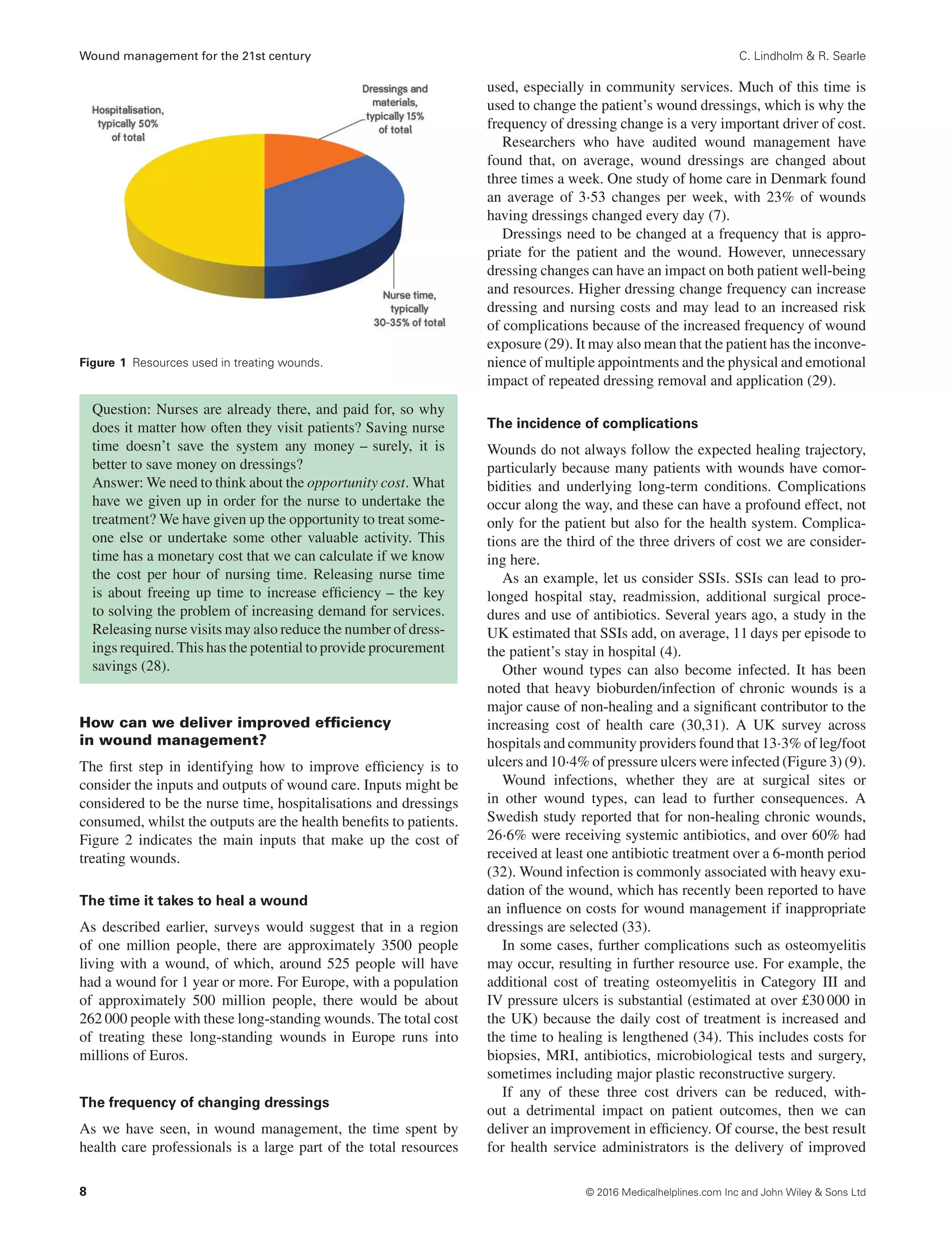
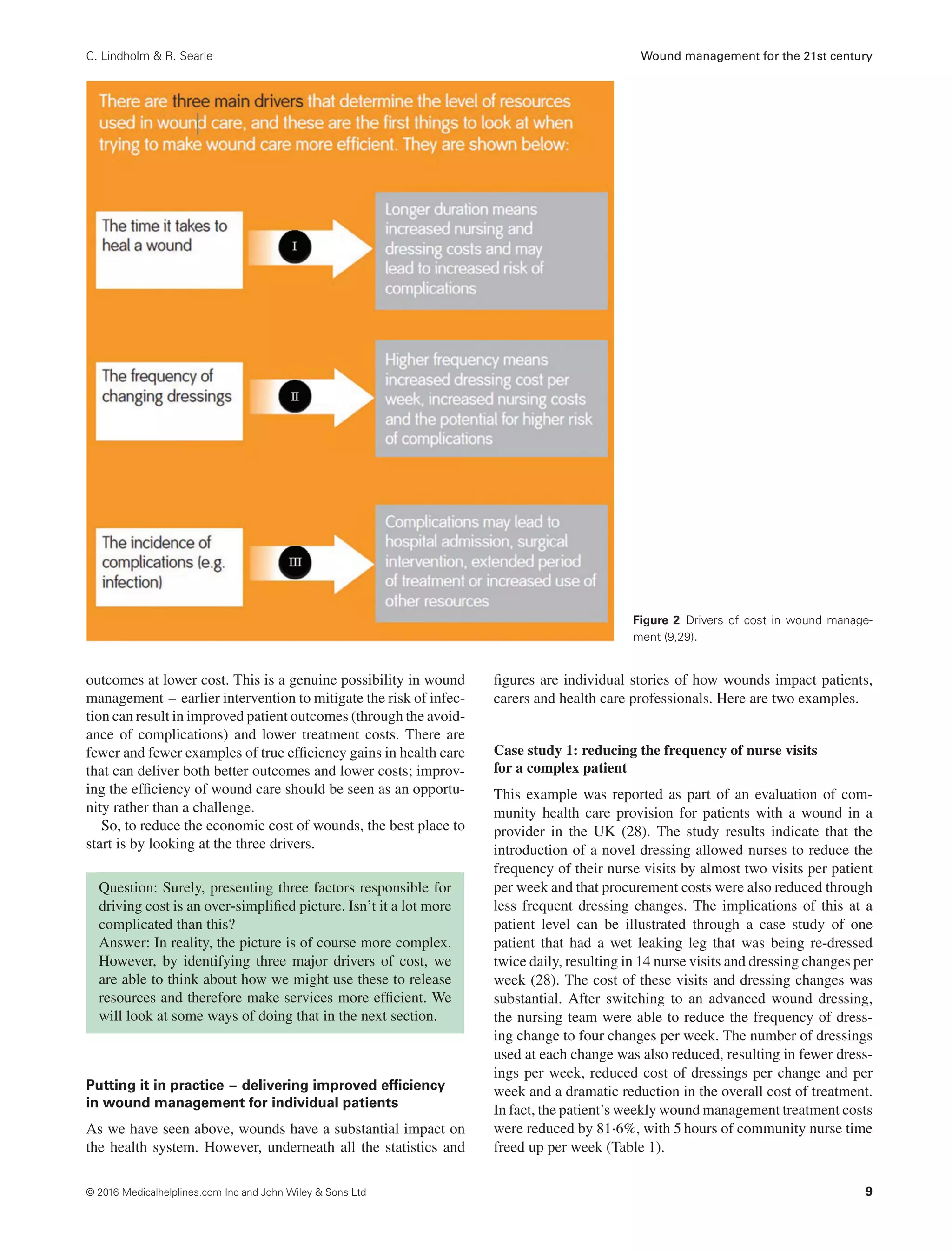

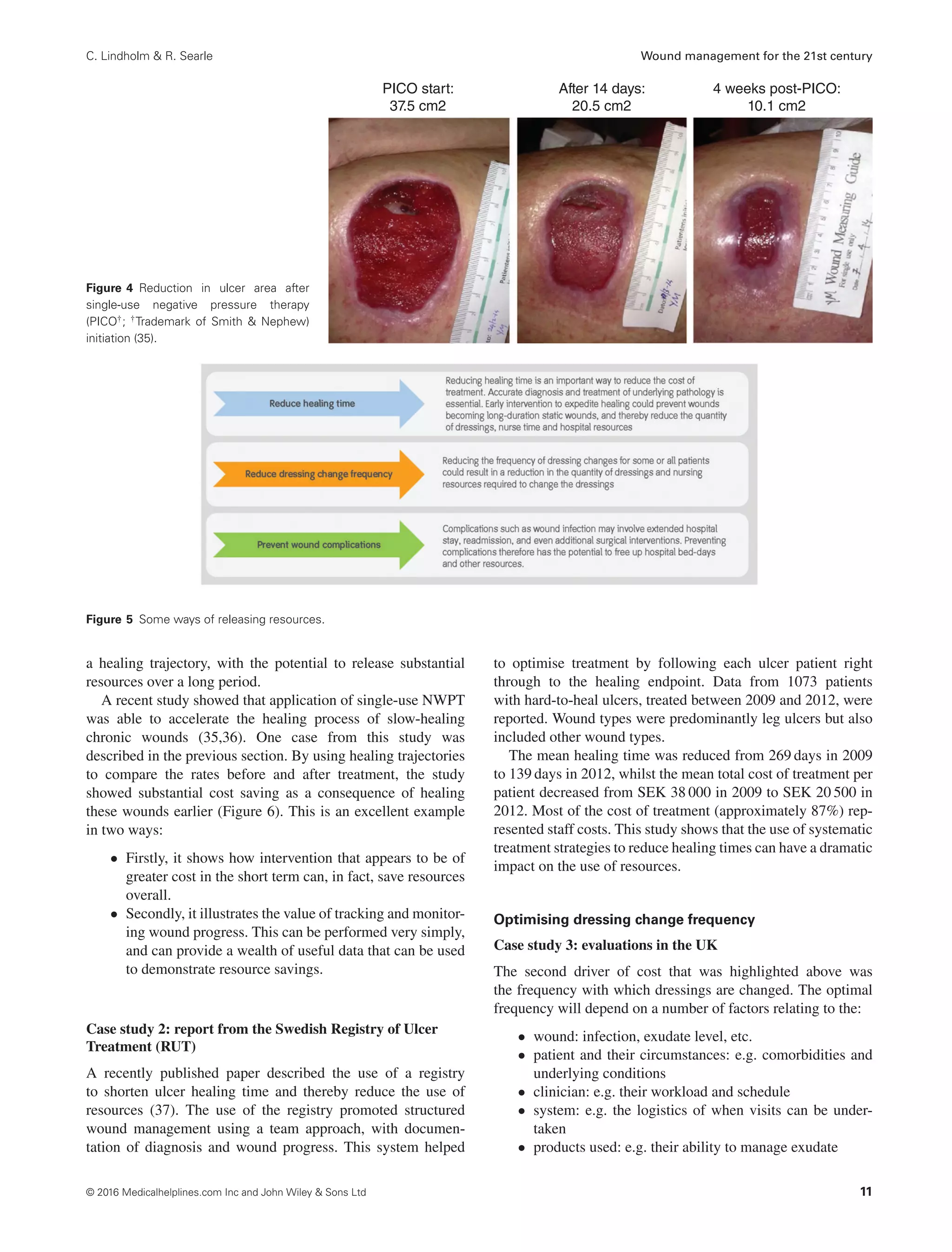
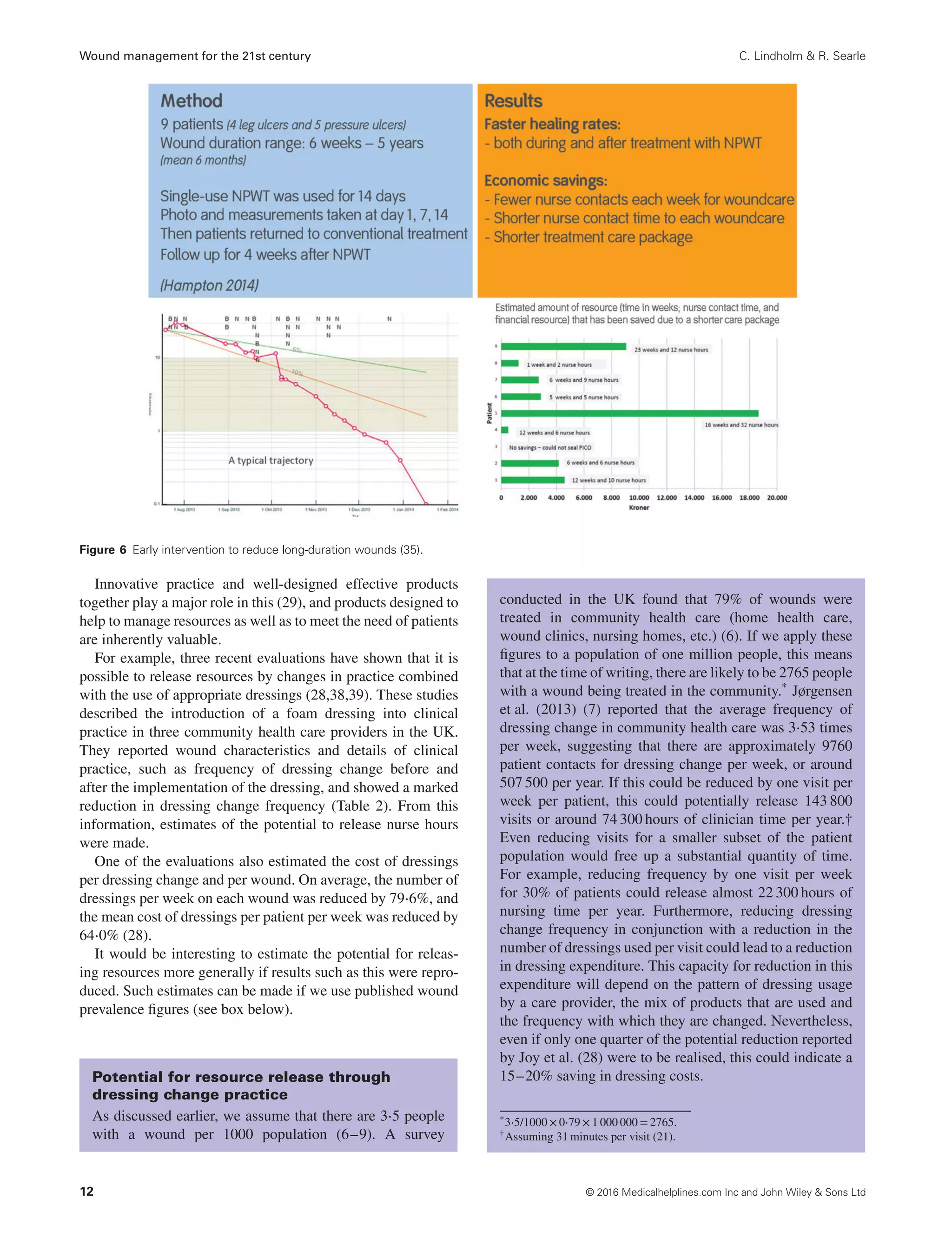
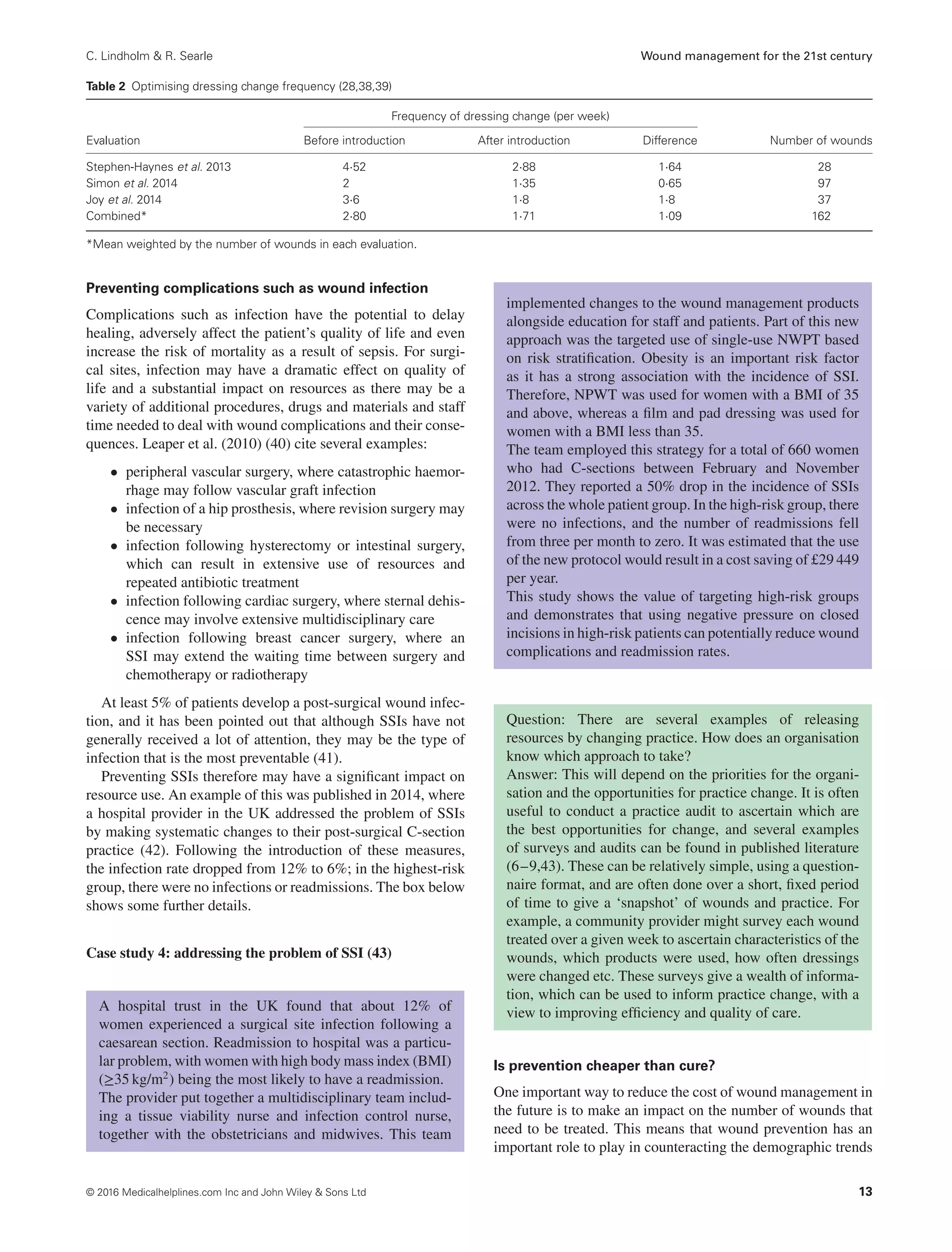
![Wound management for the 21st century C. Lindholm & R. Searle
affecting wound prevalence. For example, below-knee gradu-
ated compression hosiery is recommended to prevent recur-
rence of VLUs in patients with healed ulcers (44), and regular
foot assessments are effective to prevent DFUs alongside other
interventions such as optimising glycaemic control and smok-
ing cessation (45).
Often, when we think of wound prevention, it is the preven-
tion of pressure ulcers in acute care that comes to mind, and
indeed this is probably the most widely studied area and has
received the most attention. Having a pressure ulcer has a pro-
found adverse effect on many aspects of a person’s quality of
life, and although pressure ulcers are not a new phenomenon,
they continue to be a significant health problem as a result of an
ageing population (46). They also represent a significant burden
to health systems, with one report estimating that treatment of
pressure ulceration costs the US $11 billion annually (47).
Recently published international guidelines for the preven-
tion and treatment of pressure ulcers have demonstrated that
there a number of important considerations for prevention to be
effective (48):
• risk assessment
• skin and tissue assessment
• preventive skin care
• the use of emerging therapies such as microclimate con-
trol, prophylactic dressings, fabrics and textiles and elec-
trical muscle stimulation
• good nutrition
• repositioning and early mobilisation
• the appropriate use of support surfaces
Thorough and comprehensive risk assessment is a vital part
of prevention, and several assessment tools have been devel-
oped that, when used in conjunction with clinical judgement
and experience, can help to identify the risk level for individual
patients (49). As there are several potential risk factors for
pressure damage, there are a number of different prevention
approaches that can be used in a prevention protocol. For
a given patient, the mix of these different components will
vary (49).
Suitable support surfaces should be used, and the patient’s
skin should be inspected regularly along with a tailored reposi-
tioning programme (49). Incontinence, skin moisture, nutrition
and hydration must all be managed in collaboration with the
appropriate health care professionals (49). The use of multilayer
foam dressings has also, in recent years, become a valuable
addition to the tools available for pressure ulcer prevention, par-
ticularly for high-risk patients such as those in high-dependency
or intensive care units (49). Such dressings have been shown to
reduce the incidence of PU in these patient groups, and some
hospitals have the use of these dressings as part of their PU
prevention protocol. The choice of dressings is important: they
must have the ability to redistribute pressure, reduce shear and
friction and effectively manage temperature and moisture at the
skin surface. Where surrounding skin is fragile, as is often the
case with patients at risk of PU, dressings with a soft silicone
border may be appropriate (49).
Much has been done to improve and implement pressure
ulcer prevention measures across Europe. Economic incentives
for the reduction of PU incidence and financial penalties for
increased incidence have been introduced in some countries.
Awareness has increased, and practice has improved, although
there is continued debate about the proportion of pressure ulcers
that are avoidable (50). However, there is more that can be
carried out to adopt strategic approaches to prevention and to
use effective risk-assessment methods (51).
Conclusions
Wounds have a significant impact both on the quality of life of
those who have them and on the world’s health systems. The
number of people with wounds is growing, and this is likely
to continue into the future as a result of demographic trends.
Preventing wounds from occurring has an important role to play
in mitigating the effects of demographic changes that affect
wound prevalence.
We can think systematically about the cost of caring for
people with wounds by considering the resources used. Human
resource is the most valuable asset that the health system has,
and most of the resource used in wound management is as a
result of hospital treatment or nursing visits. Materials such
as dressings account for a relatively small amount of the cost;
however, the choice of materials and dressings used is very
important.
There are three significant drivers of cost: the time it takes
a wound to heal, the frequency of visits by health care profes-
sionals and the incidence of complications.
These three drivers help us to think about how we can make
wound management more efficient by:
• reducing healing time
• optimising dressing change frequency
• preventing complications such as wound infection.
Acknowledgements
With thanks to John Posnett, Paul Trueman, Carina Ekbladh,
Trine Gram and Jane Hampton for valuable contributions to
the content presented here. Christina Lindholm is an indepen-
dent researcher at Sophiahemmet University, Sweden. Richard
Searle is an employee of Smith & Nephew. This work was
funded by Smith & Nephew.
References
1. Harding K. Understanding healing after skin breakdown. In: Skin
breakdown – the silent epidemic. Hull: Smith & Nephew Foundation,
2007:13–16.
2. Smith & Nephew Foundation (2007). Skin breakdown – the silent
epidemic. Smith & Nephew Foundation, Hull.
3. Wounds International (2012). International consensus. Optimising
wellbeing in people living with a wound. Wounds International,
London.
4. Posnett J, Gottrup F, Lundgren H, Saal G. The resource impact of
wounds on health-care providers in Europe. J Wound Care 2009;18:
154–61.
5. Troxler M, Vowden K, Vowden P. Integrating adjunctive therapy
into practice: the importance of recognising ‘hard-to-heal’ wounds.
World Wide Wounds 2006. URL http://www.worldwidewounds.com/
2006/december/Troxler/Integrating-Adjunctive-Therapy-Into-Practice.
html [accessed on November 2015].
14 © 2016 Medicalhelplines.com Inc and John Wiley & Sons Ltd](https://image.slidesharecdn.com/lindholm2016-220204043809/75/Lindholm2016-10-2048.jpg)
![C. Lindholm & R. Searle Wound management for the 21st century
6. Vowden K, Vowden P, Posnett J. The resource costs of wound care
in Bradford and Airedale primary care trust in the UK. J Wound Care
2009;18:93–102.
7. Jørgensen SF, Nygaard R, Posnett J. Meeting the challenges of wound
care in Danish home care. J Wound Care 2013;22:540–2, 544–5.
8. Gottrup F, Henneberg E, Trangbæk R, Bækmark N, Zøllner K,
Sørensen J. Point prevalence of wounds and cost impact in the acute
and community setting in Denmark. J Wound Care 2013;22:413–4,
416, 418–22.
9. Drew P, Posnett J, Rusling L. The cost of wound care for a local
population in England. Int Wound J 2007;4:149–55.
10. Srinivasaiah N, Dugdall H, Barrett S, Drew PJ. A point prevalence sur-
vey of wounds in north-east England. J Wound Care 2007;16:413–6,
418–9.
11. Lindholm C, Andersson H, Fossum B, Jörbeck H. Wounds scrutiny in a
Swedish hospital: prevalence, nursing care and bacteriology, including
MRSA. J Wound Care 2005;14:313–9.
12. Eucomed Wound Care Policy Paper. URL http://ewma.org/fileadmin/
user_upload/EWMA/pdf/EWMA_Projects/090923__Wound_Care_
Brochure_final.pdf [accessed on June 2015].
13. Sen CK, Gordillo GM, Roy S, Kirsner R, Lambert L, Hunt TK, Gottrup
F, Gurtner GC, Longaker MT. Human skin wounds: a major and
snowballing threat to public health and the economy. Wound Repair
Regen 2009;17:763–771.
14. Santamaria N. Woundswest: identifying the prevalence of wounds
within western Australia’s public health system. EWMA Journal
2009;9:13–8.
15. Bermark S, Zimmerdahl V, Muller K. Prevalence investigation of
pressure ulcers. EWMA J 2004;4:1, 7–11.
16. Guest JF, Ayoub N, McIlwraith T, Uchegbu I, Gerrish A, Weidlich D,
Vowden K, Vowden P. Health economic burden that wounds impose
on the National Health Service in the UK. BMJ Open 2015;5:e009283.
doi: 10.1136/bmjopen-2015-009283.
17. Phillips CJ, Humphreys I, Fletcher J, Harding K, Chamberlain G,
Macey S. Estimating the costs associated with the management of
patients with chronic wounds using linked routine data. Int Wound J
2015. doi: 10.1111/iwj.12443.
18. Zimlichman E, Henderson D, Tamir O, Franz C, Song P, Yamin
CK, Keohane C, Denham CR, Bates DW. Health care-associated
infections – a meta-analysis of costs and financial impact on the US
health care system. JAMA Intern Med 2013;173:2039–46.
19. Defez C, Fabbro-Peray P, Cazaban M, Boudemaghe T, Sotto A,
Daurès JP. Additional direct medical costs of nosocomial infections:
an estimation from a cohort of patients in a French university hospital.
J Hosp Infect 2008;68:130–6.
20. Smith & Nephew. The true cost of wounds and how to reduce it. URL
http://www.smith-nephew.com/documents/uk/the-true-cost-of-wound-
booklet.pdf [accessed on April 2016].
21. O’Keeffe M. Evaluation of a community-based wound care pro-
gramme in an urban area. Poster presented at EWMA Conference;
Prague: Czech Republic, 2006.
22. Dowsett C, Bielby A, Searle R. Reconciling increasing wound care
demands with available resources. J Wound Care 2014;23:552–62.
doi: 10.12968/jowc.2014.23.11.552.
23. Kjeldsen SB. Tidspres er en trussel mod patientsikkerheden. Sygeple-
jersken 2015;2015:24–7.
24. The Royal College of Nursing. Frontline First: Nursing on Red
Alert April 2013. London: The Royal College of Nursing. URL
http://wwwrcnorguk/__data/assets/pdf_file/0003/518376/004446pdf
[accessed on July 2014].
25. International Diabetes Federation. Diabetes Atlas 5th Edition, 2015.
URL www.idf.org [accessed on November 2015].
26. Clayton W, Elasy TA. A review of the pathophysiology, classifica-
tion, and treatment of foot ulcers in diabetic patients. Clin Diabetes
2009;27:52–8.
27. Hjort A, Gottrup F. Cost of wound treatment to increase significantly
in Denmark over the next decade. J Wound Care 2010;19:173–4, 176,
178, 180, 182, 184.
28. Joy H, Bielby A, Searle R. A collaborative project to enhance effi-
ciency through dressing change practice. J Wound Care 2015;24:312,
314–7.
29. Stephen-Haynes J, Bielby A, Searle R. Putting patients first: reducing
the human and economic costs of wounds. Wounds UK 2011;7:47–55.
30. Siddiqui AR, Bernstein JM. Chronic wound infection: facts and con-
troversies. Clin Dermatol 2010;28:519–26.
31. Vowden P. Hard-to-heal wounds made easy. Wounds International,
Schofield Healthcare Media Ltd: Norwich, UK, 2011;2. URL
http://www.woundsinternational.com.
32. Tammelin A, Lindholm C, Hambraeus A. Chronic ulcers and antibiotic
treatment. J Wound Care 1998;7:435–7.
33. Benbow M. The expense of exudate management. Br J Nurs
2015;24(15 Suppl):S8.
34. Dealey C, Posnett J, Walker A. The cost of pressure ulcers in the United
Kingdom. J Wound Care 2012;21:261–266.
35. Hampton J. Accelerated wound healing in a community setting, 2014.
URL http://www.smith-nephew.com/documents/nordics/dk/nordic%
20network%20meeting/accelerated%20wound%20healing%20in%20a
%20community%20setting_jane%20hampton.pdf
36. Hampton J. Providing cost-effective treatment of hard-to-heal wounds
in the community through use of NPWT. Br J Community Nurs
2015;S14:S16–20.
37. Öien RF, Forssell H, Ragnarson Tennvall G. Cost consequences due to
reduced ulcer healing times – analyses based on the Swedish Registry
of Ulcer Treatment. Int Wound J 2015. doi: 10.111/iwj.12465.
38. Stephen-Haynes J, Bielby A, Searle R. The clinical performance of
a silicone foam in an NHS community trust. J Community Nurs
2013;27:50–9.
39. Simon D, Bielby A. A structured collaborative approach to appraise the
clinical performance of a new product. Wounds UK 2014;10:80–7.
40. Leaper NJ, Roberts C, Searle R. Economic and clinical contributions
of an antimicrobial barrier dressing: a strategy for the reduction of
surgical site infections. J Med Econ 2010;13:447–52.
41. Leaper DJ. Surgical site infection. Br J Surg 2010;97:1601–2.
42. Bullough L, Wilkinson D, Burns S, Wan L. Changing wound care
protocols to reduce postoperative caesarean section infection and
readmission. Wounds UK 2014;10:72–6.
43. Ousey K, Stephenson J, Barrett S, King B, Morton N, Fenwick K, Carr
C. Wound care in five English NHS trusts: results of a survey. Wounds
UK 2013;9:20–8.
44. Scottish Intercollegiate Guidelines Network. Management of chronic
venous leg ulcers – a national clinical guideline. Edinburgh: Health-
care Improvement Scotland, 2010.
45. Singh N, Armstrong DG, Lipsky BA. Preventing foot ulcers in patients
with diabetes. JAMA 2005;293:217–28.
46. Moore Z, Cowman S. Quality of life and pressure ulcers: a literature
review. Wounds UK 2009;5:58–65.
47. U.S. Department of Health and Human Services. AHRQ Research
Activities Issue, 2011; 371: 31.
48. National Pressure Ulcer Advisory Panel. European Pressure Ulcer
Advisory Panel and Pan Pacific Pressure Injury Alliance, 2014. Clini-
cal practice guideline: prevention and treatment of pressure ulcers.
49. Sammon M, Dunk AM, Verdú J. Advances in pressure ulcer prevention
and treatment. Wounds International, Schofield Healthcare Media Ltd:
Norwich, UK, 2015.
50. Downie F, Guy H, Gilroy P, Royall D, Davies S. Are 95% of hospital-
acquired pressure ulcers avoidable? Wounds UK 2013;9:16–22.
51. Källman U, Suserud B. Knowledge, attitudes and practice among
nursing staff concerning pressure ulcer prevention and treat-
ment – a survey in a Swedish healthcare setting. Scand J Caring
Sci 2009;23:334–41.
© 2016 Medicalhelplines.com Inc and John Wiley & Sons Ltd 15](https://image.slidesharecdn.com/lindholm2016-220204043809/75/Lindholm2016-11-2048.jpg)